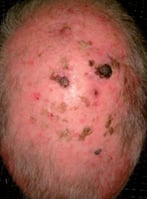sun damage repair
Sun damage repair
Topical treatments to reduce your skin cancer risk and treat superficial skin cancers, precancerous lesions, sun spots and more, with excellent cosmetic results on sun-damaged and sun-aged skin.
Select location
-
TAS
-
VIC
-
QLD
-
NSW
-
WA
Ideal treatment for:
|
|
Sun damage is a major precursor to skin cancer and the presence of scaly sun damage dramatically increases your chance of developing skin cancer in that area. Treatment is highly recommended to reduce your risk.
Topical sun damage field treatments are an effective way to treat sun damaged skin on large areas like the face, scalp, hands, décolletage, and legs. Field treatments not only reduce your risk of developing skin cancer in the future but also improve the quality and appearance of the skin overall.
Book an appointment at a location near you
What does sun damaged skin look like and why treat it?
The sun irreversibly damages and prematurely ages our skin. Evidence of those hours in the sun later show up on our face, chest, neck, and arms. The signs appear as rough scaly patches, broken capillaries, wrinkles, sagging skin, freckles, uneven pigmentation, and dark spots. Sometimes they show up as precancerous lesions or skin cancer.
Precancerous sunspots appear as scaly raised skin spots. Although you can scratch off the scale – often revealing a pink or red flat spot underneath – this will start to grow back in a matter of days. The presence of scaly, sun damaged skin significantly increases your likelihood of developing skin cancer in the same area. This is because your skin’s natural healing properties have already been compromised and are therefore less effective in fighting off more malicious attacks.
Treating sun damage helps to recharge your skin’s defences and ward off skin cancer. Furthermore, many people can feel self-conscious about the scaly appearance of their sun damaged skin, so treatment that removes that roughness may give you a welcome confidence boost.
Photodynamic therapy before and after
  |
  |
  |
How it works
Topical sun damage field treatments are safe and effective in treating large areas of skin with certain superficial and precancerous lesions, helping to treat skin cancers without surgery.
Photodynamic therapy (PDT)
A topical medicated cream is applied to your skin and activated by a specialised light source. This destroys cancerous, precancerous, and sun-damaged cells while healthy cells remain intact, promoting promotes smoother, clearer and healthier skin in a few days. PDT is an effective, safe and long-lasting skin cancer treatment for certain superficial and precancerous lesions as recommended by your doctor and can further reduce your risk of developing non-melanoma skin cancers in the treatment area for patients with a history of basal and squamous cell carcinomas.
Photodynamic rejuvenation for cancer provides excellent cosmetic results for those who have heavily sun-damaged or sun-aged skin. It also calms acne and rosacea.
Rapid solar repair therapy
Rapid solar repair therapy is a combination cream treatment which has been shown in rigorous research trials to be a highly effective treatment for solar keratoses (sun spots) and to substantially reduce the future development of squamous cell carcinomas. The treatment is suitable for the scalp, face, chest, arms and legs. It specifically targets precancerous cells and sun damaged skin, causing a skin reaction, but has limited effect on normal skin. Generally, skin with more sun damage will have a more intense reaction. Rapid solar repair therapy is a non-surgical skin cancer treatment that results in healthier, smoother skin with a reduced risk of skin cancers in the future.
During your initial consultation with the doctor, you will receive a treatment pack which may include a pre-treatment cream to prepare your skin for 1-2 weeks prior to the start of the rapid solar repair therapy. The doctor will then prepare your skin in-clinic and apply the first dose of the cream. At home, you will continue to apply the cream for 4-6 days and send photos each day. You will see the doctor after 2 and 8 weeks to assess your response and consider the need for further treatment. It is very important that you use strict sun protection / avoid the sun for a week, and then use SPF50 sunscreen daily for life once healed.
Benefits
Non-surgical treatment without scarring
Topical sun damage repair is a non-surgical treatment option for skin cancers, precancerous lesions, sun-damaged skin, acne, rosacea and more, that achieves effective and safe results without scarring or the long downtime typically associated with surgical therapies.
Prevent skin cancers
Studies confirm that topical sun damage repair treatments substantially reduce the future development of squamous cell carcinomas in the treated area, thereby reducing your skin cancer risk.
Clear, healthy skin
Since topical sun damage treatments specifically target damaged skin cells, healthy cells are left intact to reveal bright, smooth and healthy skin in just a few days.
Treat acne, rosacea & sun damage
A versatile treatment for damaged skin, these topical therapies are ideal for acne, rosacea, ageing, and other skin conditions like general sun damage.

Frequently asked questions
What should I be aware of before photodynamic therapy treatment?
You may be advised to book a standard red LED light therapy treatment 2-3 days prior to your PDT treatment to help stimulate the healing mechanism of the skin.
Close windows, blinds and skylights before leaving your house for your treatment as you will become very light-sensitive after the treatment.
Inform your doctor of any significant medical history and provide a complete list of medications as some may interfere with PDT.
A history of cold sores is very important to mention to your doctor, but does not mean you cannot have PDT. An antiviral treatment can be commended before your treatment.
How long does photodynamic therapy take?
Prepare to stay in the centre for 2-3 hours as you must not go outside during the treatment. You may undergo a light microdermabrasion treatment if your treatment area is the face. The incubation time for the 5 ALA cream varies from patient to patient. Once the cream is washed off, the LED light therapy will take 10-20 minutes.
Does photodynamic therapy hurt?
There is a degree of discomfort involved. The red LED lights are bright and hot; the skin undergoes the equivalent of a burn. Soothing gels will be applied after your treatment and further cream will be supplied to assist with comfort and healing at home.
Are there any side effects from photodynamic therapy?
There have not been any reported serious side effects of PDT, however it can be an uncomfortable experience and the degrees of reaction can vary. You must carry out a good hygiene approach after leaving the centre to avoid infection. Wash your hands regularly, do not pick at the skin, and stay away from dirty environments.
How much downtime will I need?
Your post-treatment downtime will vary depending on the nature of your work and whether you work indoors or outdoors. As a guide, a minimum of 1-2 weeks downtime is recommended following PDT treatment. Shorter periods of downtime can be expected with a milder treatment approach.
Immediately after your PDT treatment, you will feel light-sensitive. You should remain indoors as much as possible. Avoid sunlit windows and bright indoor lights. If you must go outside for very brief periods, wear a broad-brimmed hat and SPF50+ sunscreen once your skin can tolerate it.
Days 1-2: Extreme light-sensitivity. Stay indoors.
Says 3-5: Red and tender skin which may start to peel, scab and flake off. This means the treatment has worked well.
Days 6-9: Redness starts to ease. Skin may be itchy, tight and uncomfortable.
Days 10-14: Smooth, healthy skin begins to form. Pink glow should fade over ensuing weeks.
What is the aftercare procedure for photodynamic therapy?
Avoid UV exposure for one week and wear protective clothing, a broad-brimmed hat and dark sunglasses. Wear SPF50+ sunscreen all year-round.
Do not use exfoliation treatments on the treated area. Only use the creams supplied.
Do not wear make-up while your skin is healing.
Commence your regular skincare routine 2-4 weeks after your PDT treatment, with exfoliants, microneedling, antioxidants and moisturiser.
What precautions must I take during treatment with rapid solar repair therapy?
- Minimise sun exposure between 8am-6pm.
- Wear protective clothing each time you leave the home (including while driving). This includes a wide-brimmed hat, high-collar long-sleeved shirt and/or pants depending on your treatment areas.
- If the treated area cannot be covered by clothing, use sunscreen containing zinc or titanium (most “baby” brands).
- Stop current skin products. Use only gentle soap, plain Vaseline ointment, and a zinc-based sunscreen SPF50 on the treatment area.
Are there any side effects from rapid solar repair therapy?
Common side effects include:
- Itching, burning, tenderness, redness, oozing, mild swelling, crusting.
- Crusting/scabs which may take up to 2 weeks to heal.
- Redness (disappears over a couple of months).
Uncommon/rare* side effects include:
- Ulceration: Deep bleeding sores in the treatment area.
- Infection: Severe swelling, foul-smelling milky drainage, with or without fever.
- Fatigue, nausea, vomiting, diarrhea, sores in the mouth.
How much does rapid solar repair therapy cost?
At this stage Medicare does not cover rapid solar repair treatments. You will be bulk billed for your consultation/s with the treating doctor. Your out-of-pocket cost for the cream and expert care provided at the centre is $200 per treatment area.
We know skin
Medical and cosmetic
skin concerns addressed
by certified skin experts.
We keep you safe
Expert consultations and
safe treatments delivered
in a medical facility.
We delve deeper
Comprehensive approach
to overall skin health and
personalised treatments.
We achieve results
Patient-centred focus to
achieve healthy, beautiful
skin for life.
